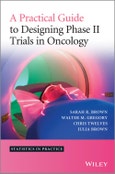How to identify optimal phase II trial designs
Providing a practical guide containing the information needed to make crucial decisions regarding phase II trial designs, A Practical Guide to Designing Phase II Trials in Oncology sets forth specific points for consideration between the statistician and clinician when designing a phase II trial, including issues such as how the treatment works, choice of outcome measure and randomization, and considering both academic and industry perspectives. A comprehensive and systematic library of available phase II trial designs is included, saving time otherwise spent considering multiple manuscripts, and real-life practical examples of using this approach to design phase II trials in cancer are given.
A Practical Guide to Designing Phase II Trials in Oncology:
- Offers a structured and practical approach to phase II trial design
- Considers trial design from both an academic and industry perspective
- Includes a structured library of available phase II trial designs
- Is relevant to both clinical and statistical researchers at all levels
- Includes real life examples of applying this approach
For those new to trial design, A Practical Guide to Designing Phase II Trials in Oncology will be a unique and practical learning tool, providing an introduction to the concepts behind informed decision making in phase II trials. For more experienced practitioners, the book will offer an overview of new, less familiar approaches to phase II trial design, providing alternative options to those which they may have previously used.
Table of Contents
Contributors 5
Preface (to come)
Foreword 6
1 Introduction 7
1.1 The role of phase II trials in cancer 8
1.2 The importance of appropriate phase II trial design 11
1.3 Current use of phase II designs 12
1.4 Identifying appropriate phase II trial designs 13
1.5 Potential trial designs 16
1.6 Using the guidance to design your trial 17
2 Key points for consideration 18
2.1 Stage 1 – Trial questions 19
2.1.1 Therapeutic considerations 19
2.1.2 Primary intention of trial 22
2.1.3 Number of experimental treatment arms 23
2.1.4 Primary outcome of interest 23
2.2 Stage 2 – Design components 24
2.2.1 Outcome measure and distribution 24
2.2.2 Randomisation 28
2.2.3 Design Category 33
2.3 Stage 3 – Practicalities 42
2.3.1 Practical considerations 42
2.3.2 Summary 44
3 Designs for single experimental therapies with a single arm 45
3.1 One-stage designs 45
3.2 Two-stage designs 49
3.3 Multi-stage designs 64
3.4 Continuous monitoring designs 70
3.5 Decision theoretic designs 74
3.6 Three-outcome designs 75
3.7 Phase II/III designs 77
4 Designs for single experimental therapies including randomisation 77
4.1 One-stage designs 77
4.2 Two-stage designs 81
4.3 Multi-stage designs 84
4.4 Continuous monitoring designs 85
4.5 Three-outcome designs 86
4.6 Phase II/III designs 87
4.7 Randomised discontinuation designs 91
5 Treatment selection designs 92
5.1 Including a control arm 93
5.1.1 One-stage designs 93
5.1.2 Two-stage designs 94
5.1.3 Multi-stage designs 97
5.1.4 Continuous monitoring designs 98
5.1.5 Decision theoretic designs 98
5.1.6 Three-outcome designs 98
5.1.7 Phase II/III designs - same primary outcome measure at phase II and phase III 99
5.1.8 Phase II/III designs - different primary outcome measures at phase II and phase III 109
5.1.9 Randomised discontinuation designs 113
5.2 Not including a control arm 113
5.2.1 One-stage designs 113
5.2.2 Two-stage designs 116
5.2.3 Multi-stage designs 119
5.2.4 Continuous monitoring designs 120
5.2.4.4 Time-to-event outcome measure 121
5.2.5 Decision theoretic designs 121
5.2.6 Three-outcome designs 121
5.2.7 Phase II/III designs - same primary outcome measure at phase II and phase III 121
5.2.8 Randomised discontinuation designs 122
6 Designs incorporating toxicity as a primary outcome 123
6.1 Including a control arm 123
6.1.1 One-stage designs 123
6.1.2 Two-stage designs 124
6.1.3 Multi-stage designs 126
6.2 Not including a control arm 127
6.2.1 One-stage designs 127
6.2.2 Two-stage designs 129
6.2.3 Multi-stage designs 133
6.2.4 Continuous monitoring designs 136
6.3 Toxicity alone 137
6.3.1 One-stage 137
6.3.2 Continuous monitoring 138
6.4 Treatment selection based on activity and toxicity 140
6.4.1 Two-stage designs 140
6.4.2 Multi-stage designs 140
6.4.3 Continuous monitoring designs 141
7 Chapter 7: Designs evaluating targeted subgroups 142
7.1 One-stage designs 142
7.2 Two-stage designs 143
7.3 Multi-stage designs 146
7.4 Continuous monitoring designs 149
8 “Chemo-radio-sensitisation” in head and neck cancer 151
9 Combination chemotherapy in second-line treatment of non-small cell lung cancer 160
10 Selection by biomarker in prostate cancer 170
11 Dose selection in advanced multiple myeloma 180
12 Targeted therapy for advanced colorectal cancer 189
13 Phase II Oncology Trials: perspective from industry 198
13.1 Introduction 198
13.2 A commercial perspective 200
13.3 Basic strategies addressed by phase II studies 201
13.3.1 Potential registration 202
13.3.2 Determine Exploratory Activity 205
13.3.3 Regimen Selection 206
13.3.4 Phase II to support predicting success in phase III 209
13.3.5 Phase II safety trials 212
13.3.6 Prospective identification of target populations 213
13.4 Discussion 215
Index








